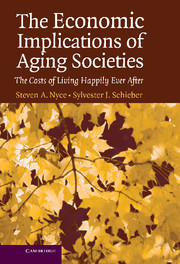Book contents
- Frontmatter
- Contents
- List of Figures and Tables
- Preface
- Acknowledgments
- 1 Introduction
- 2 Population Developments in a Global Context
- 3 Pension Options, Motivations and Choices
- 4 Pension Structures and the Implications of Aging
- 5 Retirement Systems and the Economic Costs of Aging
- 6 Beyond Pensions to Health Care Considerations
- 7 Labor Supply and Living Standards
- 8 Too Many Wants or Too Few Workers?
- 9 Alternatives to Finding More Workers
- 10 Aligning Retirement Policy with Labor Needs
- 11 Funding Pensions and Securing Retiree Claims
- 12 Macroeconomic Policies for Improved Living Standards
- 13 Risks Associated with Alternative Public Policies
- 14 Roadmap to the Future
- Index
7 - Labor Supply and Living Standards
Published online by Cambridge University Press: 09 August 2009
- Frontmatter
- Contents
- List of Figures and Tables
- Preface
- Acknowledgments
- 1 Introduction
- 2 Population Developments in a Global Context
- 3 Pension Options, Motivations and Choices
- 4 Pension Structures and the Implications of Aging
- 5 Retirement Systems and the Economic Costs of Aging
- 6 Beyond Pensions to Health Care Considerations
- 7 Labor Supply and Living Standards
- 8 Too Many Wants or Too Few Workers?
- 9 Alternatives to Finding More Workers
- 10 Aligning Retirement Policy with Labor Needs
- 11 Funding Pensions and Securing Retiree Claims
- 12 Macroeconomic Policies for Improved Living Standards
- 13 Risks Associated with Alternative Public Policies
- 14 Roadmap to the Future
- Index
Summary
Much of the discussion in the last two chapters has focused on the prospect of aging populations in the world's developed economies claiming a disproportionate share of economic output and potentially slowing economic expansion. In this chapter, we begin to explore these prospects more directly.
A fundamental dynamic in every economy is the interplay between consumer demand for goods and services and society's ability to meet that demand. From the earliest systematic study of economic behavior, economists have sought to explain the production of output in terms of its inputs. While there is no universal agreement on the mathematical formulation of the model, it is well understood that the basic building blocks of economic prosperity are determined by the number of workers and the efficiency with which output is produced.
Although economists often employ complex terminology in their descriptions, at a fundamental level, economies operate in a very simple fashion, as shown in Figured 7-1. The rate at which an economy's output – what economists call gross domestic product (GDP) – grows essentially equals the sum of labor force growth plus worker productivity growth. Labor productivity is simply how much a worker can produce in a period of time – typically economists consider hourly output as the best measure.
Labor force and productivity growth are based on three basic inputs into the production of goods and services: human capital, physical capital, and innovation.
- Type
- Chapter
- Information
- The Economic Implications of Aging SocietiesThe Costs of Living Happily Ever After, pp. 154 - 192Publisher: Cambridge University PressPrint publication year: 2005



